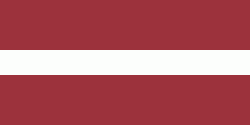Jēkabpils District (Jēkabpils Municipality)
Jēkabpils district (Jēkabpils rajons) was an administrative division of Latvia, located in Latgale region, in the country's east. It was organized into three cities and twenty one parishes, each with a local government authority. The main city in the district was Jēkabpils.
Jēkabpils lies on both banks of the Daugava River. In the south the district bordered Lithuania and the length of the border was 44 km. It bordered the former districts of Madona to the north, Aizkraukle to the west, Preiļi and Daugavpils to the east.
The total area of the district was 2,998 km², the population was 53,473, making it the fifth largest region in Latvia based on area and population.
On 4 January 2000, the unemployment rate was 10.6% of the economically active population according to the State Employment Board data.
Jēkabpils was the eighth largest city in Latvia. There were two towns in the region—Viesīte with 2,230 inhabitants and Aknīste with 1,350 inhabitants. Urban population was 32,800 people, rural 25,000 living in 20 parishes and 2 towns.
Districts were eliminated during the administrative-territorial reform in 2009.
* Aknīste city
* Asare parish
* Atašiene parish
* Ābeļi parish
Jēkabpils lies on both banks of the Daugava River. In the south the district bordered Lithuania and the length of the border was 44 km. It bordered the former districts of Madona to the north, Aizkraukle to the west, Preiļi and Daugavpils to the east.
The total area of the district was 2,998 km², the population was 53,473, making it the fifth largest region in Latvia based on area and population.
On 4 January 2000, the unemployment rate was 10.6% of the economically active population according to the State Employment Board data.
Jēkabpils was the eighth largest city in Latvia. There were two towns in the region—Viesīte with 2,230 inhabitants and Aknīste with 1,350 inhabitants. Urban population was 32,800 people, rural 25,000 living in 20 parishes and 2 towns.
Districts were eliminated during the administrative-territorial reform in 2009.
* Aknīste city
* Asare parish
* Atašiene parish
* Ābeļi parish
Map - Jēkabpils District (Jēkabpils Municipality)
Map
Country - Latvia
 |
 |
| Flag of Latvia | |
After centuries of Teutonic, Swedish, Polish-Lithuanian and Russian rule, which was mainly executed by the local Baltic German aristocracy, the independent Republic of Latvia was established on 18 November 1918 when it broke away from the German Empire and declared independence in the aftermath of World War I. However, by the 1930s the country became increasingly autocratic after the coup in 1934 establishing an authoritarian regime under Kārlis Ulmanis. The country's de facto independence was interrupted at the outset of World War II, beginning with Latvia's forcible incorporation into the Soviet Union, followed by the invasion and occupation by Nazi Germany in 1941, and the re-occupation by the Soviets in 1944 to form the Latvian SSR for the next 45 years. As a result of extensive immigration during the Soviet occupation, ethnic Russians became the most prominent minority in the country, now constituting nearly a quarter of the population. The peaceful Singing Revolution started in 1987, and ended with the restoration of de facto independence on 21 August 1991. Since then, Latvia has been a democratic unitary parliamentary republic.
Currency / Language
| ISO | Currency | Symbol | Significant figures |
|---|---|---|---|
| EUR | Euro | € | 2 |
| ISO | Language |
|---|---|
| LV | Latvian language |
| LT | Lithuanian language |
| RU | Russian language |
















